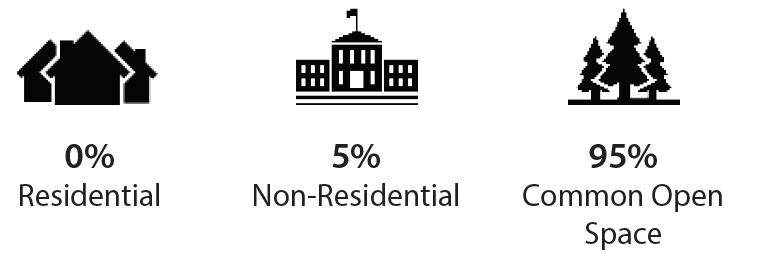 Place Types - Open Space: Recreation
Place Types - Open Space: Recreation
 Place Types - Open Space: Recreation
Place Types - Open Space: Recreation
Place Types are a classification of land that provides guidance for how future development should look and function. They describe types and intensities of land use as well as important characteristics such as scale, site design, and accessibility. These draft policies will be reviewed by staff and the community, with a final draft document anticipated in Fall 2018. You are reviewing Open Space - Recreation, one of 14 different Place Types. Thank you for your time and interest in shaping the future of our community.
DRAFT Document - Open Space: Recreation
Click this link to open a full copy of Place Types - Open Space: Recreation.
You'll need this for reference as you take the survey.
Summary
(Sidebar on right side of document)
This section summarizes the intent and rataionale for the "building blocks" of Place Types. These "building blocks" range from Land Use to Transportation.
Please share any questions/comments you have on the following "building blocks".
Goals
- Provide for active and passive recreational uses.
- Contribute to quality of life of residents and visitors by providing places to gather and recreate, and further the environmental quality of our ecosystems including the habitats, tree canopy, water, and air.
Land Use
- Uses within Open Space – Recreational may include athletic fields, recreation centers, aquatic centers, and playgrounds and similar uses.
- Passive spaces within parks provide space to relax and support the health of our air, water, and land.
- Sites should protect environmentally sensitive land like steep slopes, natural habitats, and watersheds.
Urban Design
- Buildings are generally associated with civic uses and should be sited prominently with regard to location, but in a manner that is conscientious of any sensitive environmental features.
- Impervious spaces should be minimized but may include sidewalks, plazas, fountains, buildings and parking lots.
Transportation
- Open spaces may be located along various street classifications, but once inside the open space area the transportation network typically consists of Local Streets to provide access to different facilities.
Typical Mix of Uses
Zoning Districts
- This Place Type may have one or several zoning districts that acknowledge the various functions as part of the Charlotte landscape and environment.
- Specific Zoning Districts will be developed for this Place Type – TBD.
Building Types
- Buildings are generally for civic uses such as recreation centers and restroom facilities to support the users of the open space.
- Buildings are primarily low-rise commercial and civic/institutional.
Building Size
- Building size may vary depending on the context of the surrounding area.
- Buildings are typically about 10,000 square feet, but some regional recreation facilities may be around 150,000 square feet.
Building Length Along The Street Frontage
- Building length varies based on the context of the area.
- If located near a Neighborhood or Center or near a Transit Station, shorter building lengths of no more than 100 feet without breaks in the buildings are appropriate to provide a more interesting and comfortable pedestrian environment and allow for better, more integrated block structure.
Building Height
- The height of buildings depends upon the context in which they are located, however most buildings will be a single story.
- On sites that require taller buildings, transitions to low intensity places and neighborhoods should be addressed with tapered height toward the lower intensity places and the placement of buildings farther away from them to minimize impact and respect the character of the adjacent area.
- Tall lighting structures should also be sited to minimize or eliminate impacts to neighborhoods.
Yards
- Varies by context.
Orientation
Note: Arterial Streets are higher volume streets (not freeways) that travel to and through Places. The terms Main Street, Avenue, Boulevard, and Parkway refer to the more specific design classifications (from the Urban Street Design Guidelines) that refine the generic Arterial Streets into context-based streets. Arterial Streets is used generically here, with USDG classifications applied where necessary to make distinctions between expected design and context. Local streets are lower-volume streets that provide direct access to land uses off of Arterial Streets. References to buildings are intended for buildings primarily open to the public, not those intended primarily for maintenance.
- Buildings are typically located internal to an Open Space – Recreational site and oriented toward the internal Local Street network.
- If buildings are located on sites along a Local Street, Main Street, Avenue with on-street parking, or near a Transit Station, buildings should be oriented toward the street and provide at least one entrance along the street.
- If sites are located along Arterial Streets, is is preferable that they orient to the street if it is in an Avenue or Boulevard. Along Parkways, buildings may orient toward internal streets. Buildings set farther back from an Arterial Street should still include clearly visible and direct pedestrian connections.
Building Frontages Along Streets
- Buildings should include operable entrances and significant transparency along street frontages.
- Buildings not located adjacent to the street should include clear connections to all nearby streets.
- Parking (other than on-street parking) should not be located between the building and street on Main Streets and Avenues.
- At least one building entrance should be provided from the sidewalk along the street.
- Space between the building and the sidewalk may provide appropriate locations for outdoor seating or usable open space, which can positively contribute to an improved public realm.
Building Coverage and Impervious Surface
- Impervious surfaces typically cover around 20% of development within the overall open space area.
- Building coverage is typically up to 5% of an Open Space - Recreation area.
- Impervious surfaces may be made up of buildings, driveways, streets, parking, paved walking paths, athletic courts, among other site elements.
- Approximately 80% of land in an Open Space-Recreational area is pervious (K). These areas are typically grassed, landscaped, and can included areas programmed for recreation activities, such as ball fields.
- Pervious areas can accommodate trees that contribute to the city’s tree canopy.
Open Space and Yards
- Open space is the primary element of Open Space – Recreational.
- Common Open Spaces of various types should occupy about 95% of an Open Space – Recreational area overall. Open spaces are typically in the form of pervious surface areas like natural, grassed, or landscaped areas, athletic fields, and pervious parking areas.
- Types of Open Space - Recreational range from Neighborhood sized parks (2-20 acres) to Regional sized parks (100 acres).
- Smaller open spaces, for example community gardens, playgrounds, plazas, and landscaped areas, may also occur but are typically part of the surrounding Place Type that they support (in a Neighborhood, Center, or Sector).
- Greenways are appropriate in Open Spaces and commonly traverse and connect Open Space – Recreational to other open spaces and places.
Connectivity
- Open Space – Recreational should be accessible from surrounding places to provide convenient space for residents and visitors to enjoy.
- Open Space – Recreational should be well connected to the overall street network in an area and provide access for all modes of transportation from all edges of the space.
- The street network should continue the block pattern of surrounding areas, as feasible without detriment to environmentally sensitive areas.
Pedestrian Network
- The pedestrian network should support those walking from nearby places and transit stops and stations.
- The pedestrian network should also enable patrons to walk through the Open Space – Recreational area with comfort, ease, and convenience by providing connections that traverse the site to connect one side of the Open Space with the other.
- Direct pedestrian connections should be provided to building entrances from the internal and/or the external street and sidewalk network. There should be clear and visible on-site sidewalk connections from streets directly to buildings.
- The Local Street network provides a high-quality pedestrian environment by being both well-connected and designed to accommodate large groups of people.
- Arterial Streets also support walkability by providing a highquality public realm and frequent crossing opportunities.
- Off-street sidewalks should include connections from streets to adjacent greenways, parks, schools, and other streets where possible.
Parking
- Open Space – Recreational sites typically include parking for patrons of passive open spaces as well as for activities on athletic fields. The effects of large surface parking lots should be mitigated with planting areas and trees located at intervals throughout the lot to provide shade and maintain tree canopy coverage and water quality. Pervious parking surfaces that are not detrimental to environmental quality should also be considered.
- Parking is typically located to the side or rear of buildings, particularly along Local Streets, Main Streets, Avenues, and some Boulevards. If located between buildings and streets or no buildings are present, clear and direct pedestrian access should be provided between the street and the building entrance.
Vehicular Access
- Primary access to Open Space - Recreational sites is typically from Arterial Streets, however access points from Local Streets and nearby neighborhoods are encouraged.
- Smaller open spaces may not have vehicular access points.
Streets
- Open Space - Recreational sites may be located along any street type.
- A Local Street network may be provided for access to or through a site. Target speeds for Local Streets should be low (preferably 20-25mph).
Sidewalks
- Arterial Streets typically have minimum 6 feet wide unobstructed sidewalks on Avenues and Boulevards and a minimum 10 feet wide unobstructed sidewalks on Main Streets. Wider sidewalks are encouraged along park edges.
- Internal Local Streets and driveways should have sidewalks, but routes may be altered to better integrate with the internal pedestrian network.
- There should be clear and visible on-site sidewalk connections from Arterial Streets directly to buildings and to the internal pedestrian network and to any facilities.
Green Zone
- The Green Zone is typically no less than 8 feet wide to accommodate shade trees, grass, and/or hardscape elements. It provides separation between pedestrians and vehicles, helps calm traffic, provides an attractive public realm, contributes to the City’s healthy tree canopy, and shades the streets and users.
- In Open Space - Recreational, grass planting strips are appropriate on Parkways, Boulevards, and Avenues without on-street parking. They are also appropriate adjacent to most residential uses without on-street parking.
- An 8 foot hardscaped Green Zones (with trees in grates or curbed planters) may be used on Local Streets and should always be used on Main Streets, and Avenues with on-street parking.
Bicycle Facilities
- Dedicated bicycle facilities are expected on most Arterial Streets, due to higher motor vehicle speeds and volumes.
- Dedicated bicycle facilities are not typical on internal Local Streets and Main Streets, since motor vehicles speeds and traffic volumes should be low and bicycles and motor vehicles can safely share the travel lane.
- Design of the bicycle facility varies (see general provisions, p. XX for factors influencing bike facilities).
- Off-street bicycle facilities should be considered along with pedestrian connections between nearby areas and through parks.
Street Furnishings
- Street furnishings should be located in the Green Zone or areas behind the sidewalk, not in the sidewalk.
- The Green Zone (if hardscaped), combined with building setback, should be wide enough to include trees in grates, pedestrian lighting, benches, transit stops/facilities, trash receptacles, outdoor seating/displays, doors and entrances, and bike parking.
